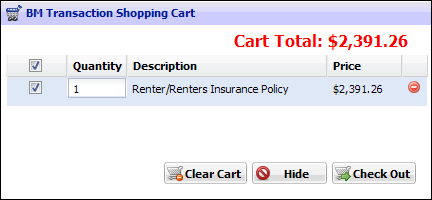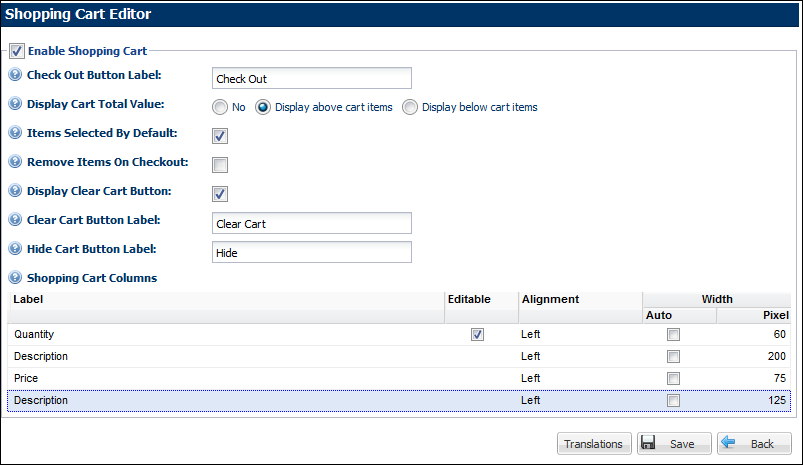Shopping Carts Administration (Oracle CPQ 22A and Prior)
Overview
The Oracle CPQ shopping cart feature is being deprecated from Legacy Configuration UI. We are working on developing a similar experience for the JET Configuration UI.
- If your implementation uses a shopping cart with Legacy Configuration UI, we recommend you to transition to the JET Configuration UI. Upon upgrade to Oracle CPQ 22B, customers will no longer have access to the shopping cart feature in their Legacy Configuration UI.
- If you have implemented a shopping cart with JET Configuration UI, upon upgrade to Oracle CPQ 22B (safe harbor), your implementation will be automatically upgraded to use the new shopping cart alternative.
This topic defines Shopping Cart administration for sites on Oracle CPQ 22A and prior.
If your site is on Oracle CPQ 22B or later, refer to the Shopping Cart Administration topic.
The shopping cart displays the total number of items in the cart and the total cost for those items. Users can add multiple products to a shopping cart before checking out. Users can selectively checkout items from the shopping cart. Upon checkout, all data is carried into the newly created commerce transaction, where the products added to the shopping cart show up as line items. Users can also add items to existing quote from the shopping cart, similar to the ‘Add from catalog’ functionality in commerce.
A shopping cart is available per Commerce Process. The FullAccess user can enable the shopping cart for a Commerce Process in the Shopping Cart Editor. By default, this functionality is disabled.
 Example of the User-Side Shopping Cart
Example of the User-Side Shopping Cart

| Description |
The description field is mapped to the Model Name for a Model and a Part Number for a part. The user cannot edit this field.
On an application supporting Price Books, the Price Book is displayed in parentheses next to the part number under the description column.
|
| Price |
The price field contains the Total Price for a configured Model. If the user adds a part and Price Books are not available, then the Price field contains the price associated with the part. If Price Books are available, the Price field contains the price of the part from the chosen Price Book. For a recommended item, the price field contains the recommended price. The end user cannot edit this field in the shopping cart. |
| Quantity |
For recommended items and for items chosen in the Multiple Parts Buy page, this field is populated by the recommended quantity/user specified quantity. The FullAccess user can choose to make this field editable. However, the user cannot modify the quantity of mandatory recommended items. Also, changing the quantity of a configured model will change the quantities of mandatory items to keep the same ratio to the configured model but will not modify the quantities of non-mandatory recommended items. |
| Cart Total |
The Cart Total provided in the Shopping Cart is a sum of item quantity multiplied by the unit price for each item. It does not allow advanced functions. |
Administration
 Enabling the Shopping Cart
Enabling the Shopping Cart
- Navigate from the Admin Home Page > Commerce and Documents > Process Definition > Select a Process > Shopping Cart > List.
- Verify that Enable Shopping Cart is selected.
-
Modify the Shopping Cart properties:

| Check Out Button Label |
Enter text that will display on the button users will click to perform the checkout action. |
| Display Cart Total |
- No
- Display Above Cart Item
- Display Below Cart Item
|
| Items Selected by Default |
Select this box if you would like the items in the shopping cart to automatically be selected for check-out when they are added to the cart. If this is not selected, the user will have to manually select items for checkout. |
| Remove Items on Checkout |
Select to have the selected items removed from the cart when they are added to a Transaction. |
| Display Clear Cart Button |
Select this box if you would like to display this button. When users choose to clear the cart, all items will be removed from the cart. |
| Clear Cart Button Label |
Enter the text that will be displayed on the Clear Cart button. |
| Hide Cart Button Label |
Enter the text that will be displayed on the Hide Cart button. |
| Shopping Cart Columns |
You can edit the text and the layout of the shopping cart. Columns can be dragged and dropped into the order you would like to have them appear. Under the Shopping Cart Columns header, there are four editable columns: Label, Editable, Alignment and Width. Under Label, you can click on the column label and edit its text. |
|
Quantity Description
|
Select the checkbox under Editable if you would like the user to be able to edit the quantity of items within the shopping cart. In the Alignment column, click on a label for the appropriate shopping cart column. A drop-down ll appear and you can choose Left, Right or Center for the alignment of each column. |
|
Price Description
|
In the Alignment column, click on a label for the appropriate shopping cart column. A drop-down will appear and you can choose Left, Right or Center for the alignment of each column. You have two choices for setting the Width of each column: Auto and Pixel. If you click the checkbox under Auto, that column will auto-size. |
- Click Save to save your changes.
- Click Back to return to the Processes List page.
 Invoking the Shopping Cart
Invoking the Shopping Cart
Commerce Invocation from the Shopping Cart is similar to invocation in other areas of the application. After enabling the Shopping Cart for a process, the FullAccess user must set up the Shopping Cart invocation in the Process Invocation section. Invocation rules are evaluated on adding items to the cart and not on checking out. If the shopping cart for a process is disabled, the Invocation buttons for it will also be disabled to make administration easier.
 Shopping Cart and Navigation Menus
Shopping Cart and Navigation Menus
Also upon enabling a shopping cart within a Commerce Process and deploying the process, a navigation menu link is automatically created. It is labeled ‘View <Commerce Process name> Shopping Cart’. The number of items in the shopping cart is displayed right next to the link for the end-user. The FullAccess user can customize this link to be whatever they want. Also, like invocation, these view cart links disappear once the shopping cart is disabled for a process to make administration easier.
Notes
The user cannot modify the quantity of mandatory recommended items. Changing the quantity of a configured model will change the quantities of mandatory items to keep the same ratio to the configured model but will not modify the quantities of non-mandatory items.
Shopping Cart is session based, therefore the user will lose all cart contents if he logs out.
It is not possible to remove the Price Book name from the parts description field within the Shopping Cart.
Users can specify a quantity up to 9999999 in the shopping cart.
Related Topics
 See Also
See Also
![]() Example of the User-Side Shopping Cart
Example of the User-Side Shopping Cart
![]() Shopping Cart and Navigation Menus
Shopping Cart and Navigation Menus







